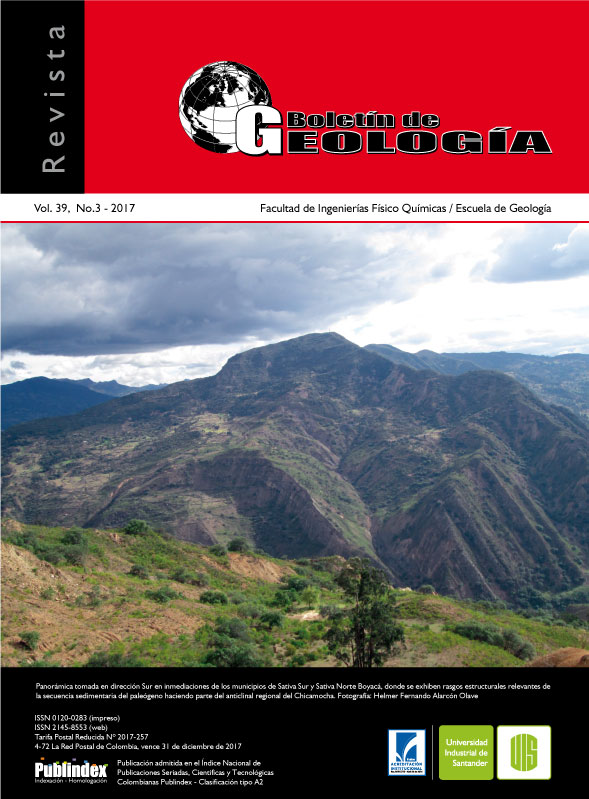Publicado 2017-10-06
Palabras clave
- magnitud de completitud,
- sismicidad en Costa Rica,
- método de Stepp
Cómo citar
Altmetrics
Resumen
En este artículo se evalúa la estabilidad de la tasa media de ocurrencia de sismos y la distribución temporal de la sismicidad en Costa Rica a partir del método de Stepp, con el fin de determinar la magnitud de completitud del catálogo sísmico de la Red Sismológica Nacional (RSN) y la relación Gutenberg-Richter para el periodo 1975- 2014. El catalogo fue depurado de acuerdo con varios criterios y homogeneizado a magnitud momento (Mw). La magnitud de completitud del catálogo total obtenida es de 5,0, pero puede disminuir hasta 3,0 para ciertos periodos de tiempo. Los resultados reflejan la mejora en la detección de sismos debido al cambio de sistemas analógicos a digitales a partir de 1990 y el aumento considerable en el número de estaciones a partir del año 1995. El valor b obtenido para todo el catálogo es 0,96, el cual es muy similar a valores regionales obtenidos en estudios previos, no obstante deben considerarse las limitaciones discutidas en el artículo para su correcta interpretación.
Descargas
Referencias
Benito, B., y Jiménez, M. 1999. Peligrosidad sísmica. Física de la Tierra, 11: 13-47.
Benito, B., Lindholm, C., Camacho, E., Climent, A., Marroquin, G., Molina, E., Rojas, W., Escobar, J., Talavera, E., Alvarado, G., and Torres, Y. 2012. A new evaluation of seismic hazard for the Central America Region. Bulletin of the Seismological Society of America. 102(2): 504-523.
Caneva, A., Salcedo, E., Van Hissenhoven, R., y Alfaro, A. 2003. Estudio de sismicidad regional para el análisis de la amenaza sísmica para Bogotá. Ingeniería y Universidad, 7(2): 133-150.
Cárdenas, C., Garzón, Y., Santa, L., y Castillo, L. 2010. Modelo de Poisson para la ocurrencia y magnitud espacio-temporal de los sismos en Colombia. UD y la Geomática. 4: 28-43.
Chouliaras, G. 2009. Investigating the earthquake catalog of the National Observatory of Athens. Natural Hazards and Earth System Sciences, 9: 905-912.
Fan, G., Beck, S., and Wallace, T. 1993. The seismic source parameters of the 1991 Costa Rica aftershock sequence: Evidence for a transcurrent plate boundary. Journal of Geophysical Research, 98(B9): 15759-15778.
Franco, A., Lasserre, D., Lyon-Caen, H., Kostoglodov, V., Molina, E., Guzman-Speziale, M., Monterosso, D., Robles, V., Figueroa, C., Amaya, W., Barrier, E., Chiquin, L., Moran, S., Flores, O., Romero, J., Santiago, J.A., Manea, M., and Manea, V. C. 2012. Fault kinematics in northern Central America and coupling along the subduction interface of the Cocos Plate, from GPS data in Chiapas (Mexico), Guatemala and El Salvador. Geophysical Journal International, 189(3): 1223-1236.
Goes, S., Velasco, A., and Schwartz, S. 1993. The April 22, 1991, Valle de la Estrella, Costa Rica (MW 7.7) earthquake and its tectonic implications: A broadband seismic study. Journal Geophysical Research, 98(B5): 8127-8142.
Gutenberg, B., and Richter, C. 1944. Frequency of earthquakes in California. Bulletin of the Seismological Society of America, 34(4): 185-188.
Knopoff, L. 2000. The magnitude distribution of declustered earthqaukes in Southern California. Proceedings of the National Academy Sciences USA, 97(22): 11880-11884.
Kulhanek, O. 2005. Seminar on b-value. Technical Report, Department of Geophysics, Charles University, Prague.
Laporte, M., Lindholm, C., Bungum, H., and Dahle, A. 1994 Seismic hazard for Costa Rica. NORSAR, Technical Report No. 2-14, 73p.
Lucke, O. 2014. Moho structure of Central America based on three-dimensional lithospheric density modelling of satellite-derived gravity data. International Journal of Earth Sciences, 103(7): 1733-1745.
Marshall, J., Fisher, D., and Gardner, T. 2000. Central Costa Rica deformed belt: Kinematics of diffuse faulting across the western Panama block. Tectonics, 19(3): 468-492.
Mendoza, A.R. 2012. Estudio de la estabilidad del valor b para regiones sismotectónicas de México. Tesis de Maestría, Universidad Nacional Autónoma de México, México. 127p.
Mignan, A., and Woessner, J. 2012. Estimating the magnitude of completeness for earthquake catalogs. Community Online Resource for Statistical Seismicity Analysis, 4: 1-45.
Montero, W. 2001. Neotectónica de la región central de Costa Rica: Frontera oeste de la microplaca de Panamá. Revista Geológica de América Central, 24: 29-56.
Montero, W., y Rojas, W. 2014. Las fallas Purires y Picagres y su relación con la secuencia sísmica de Puriscal de 1990. Revista Geológica de América Central, 50: 39-69.
Morales, L.D., 1986. Historia de la sismología en Costa Rica. Revista de Filosofía Universidad de Costa Rica, 24(59): 93-104.
Nasir, A., Lendhart, W., Hintersberger, E., and Decker, K. 2013. Assessing the completeness of historical and instrumental earthquake data in Austria and the surrounding areas. Austrian Journal of Earth Sciences, 106(1): 90-102.
Naylor, M., Orofanogiannaki, K., and Harte, D. 2010. Exploratory data analysis: Magnitude, space, and time. Community Online Resource for Statistical Seismicity Analysis, 3: 1-42.
Rojas, W. 1993. Catálogo de sismicidad histórica y reciente en América Central: Desarrollo y análisis. Tesis, Universidad de Costa Rica, Costa Rica. 91p.
Rojas, W., Cowan, H., Lindholm, C., Dahle, A., and Bungum, H. 1993. Regional seismic zonation for Central América: A preliminary model. NORSAR Report. Norway.
Sobiesiak, M. 2000. Fault plane structure of the Antofagasta, Chile Earthquake of 1995. Geophysical Research Letters, 27(4): 581-584.
Sobiesiak, M. 2005. Fault plane structure of the 1995 Antofagasta Earthquake (Chile) derived from local seismological parameters. Tesis Doctoral, Universitat Potsdam, Alemania. 137p.
Stepp, J.C. 1972. Analysis of completeness of the earthquake sample in the Puget Sound area and its effect on statistical estimates of earthquake hazard. Proceedings of the International Conference on Microzonation, 2: 897-910.
Valladares, R. 2013. Determinación de parámetros sísmicos asociados con la amenaza sísmica en la región nororiental de Venezuela. Tesis, Universidad de Oriente, Venezuela. 77p.
Wiemer, S., and Wyss, M. 2000. Minimum magnitude of completeness in earthquake catalogs: Examples from Alaska, the Western United States, and Japan. Bulletin of the Seismological Society of America, 90(4): 859-869.
Wiemer, S. 2001. A software package to analyze seismicity: ZMAP. Seismological Research Letters, 72(3): 373-382.
Woessner, J., and Wiemer, S. 2005. Assessing the quality of earthquake catalogues: Estimating the magnitude of completeness and its uncertainty. Bulletin of the Seismological Society of America, 95(2): 684-698.
